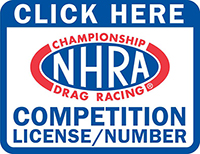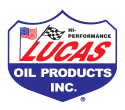

 |
| Latest News |
| Schedule |
| Results |
| Points |
| Tech Info |
| NHRA Divisions |
| Join NHRA |
| Banquet |
| Hall of Fame |
| LODRS Contng |
| Summit Contng |
| Summit ET Series |
| Jr Street |
| Chassis Inspector |
 |
|
Mike Eames, Director |
|
NHRA Sportsman Motorcycle Northwest Division Rules
NHRA NORTHWEST DIVISION Sportsman Motorcycle Rule Supplement January 2018 Part of the NHRA Division 6 Program DESIGNATION: S/MC, preceded by rider number For motorcycles running between 7.00 and 11.99 seconds and snowmobiles running between 7.50 and 11.99 seconds, using a handicapped start and a .4-second Pro Tree or .5-second full Tree. Requirements and specifications for the NHRA Sportsman Motorcycle Series are the same as those for E.T. Motorcycle and Advanced E.T. Motorcycle – Sections 4C and 4D of the NHRA Rulebook with the following exceptions: (Snowmobiles must meet all rules as per E.T. Snowmobile – Section 4E of the NHRA Rulebook) Data recorders permitted on motorcycles and snowmobiles. Refer to the current NHRA Rulebook or NHRA Rule Amendments for vehicle/rider requirements, specifications, and general regulations. REQUIREMENTS AND SPECIFICATIONS ENGINE: 1 ENGINE Must be stock-type engine specifically designed and manufactured for production motorcycle use. Snowmobile engines permitted. Automobile, aircraft, or marine engines prohibited. All engines must be self-starting; “plug-in” electric starters permitted; push or roller starts prohibited. EXHAUST Must be directed away from rider when in riding position. FUEL Racing gasoline, gasoline, gasohol, methanol, propane, natural gas, and ethanol permitted. Nitromethane prohibited. FUEL SYSTEM Fuel-shutoff valve mandatory. NITROUS OXIDE Commercially available nitrous oxide permitted. Bottles must be stamped with DOT-1800 pound rating and permanently mounted (no hose clamps or tie wraps). Hoses from bottle(s) to solenoid must be high-pressure steel-braided or NHRA-accepted hoses. Commercially available, thermostatically controlled, blanket-type warmer accepted. Any other external heating of bottle(s) prohibited. SUPERCHARGER/TURBOCHARGER Permitted. DRIVETRAIN: 2 CHAIN AND/OR BELT GUARD Mandatory. Must have front and rear chain guards to cover the width and at least the top run to the centerline of the sprocket of any chains or belts. The guards must be .060-inch steel or 1/8-inch aluminum unless stock equipped and be securely mounted. CLUTCH Use of timed clutch prohibited. Use of OEM multi-stage lockup clutch permitted if original engine/clutch combination is retained. Clutch assembly must have at least half of the side surface covered. TRANSMISSION Any transmission with a maximum of six forward speeds may be used. It must be contained within the stock case, except Harley Davidson, and shifted from gear to gear manually (or by air shifter). RPM-activated or electronic-shifted gearboxes prohibited. BRAKES & SUSPENSION: 3 BRAKES Operational front and rear brakes mandatory. Drilled disc brakes may be used if commercially manufactured or they meet the following requirements: • The original diameter must be maintained • Minimum thickness: 3/16-inch • Maximum hole size: 1/2-inch with all holes countersunk • No two holes closer than 1 1/4 inches, center to center • Mechanical front disc brakes permitted in all classes For motorcycles running 7.49 seconds or quicker, the following applies: Hydraulic brakes, front and rear, mandatory. Minimum sizes: front, 9-inch diameter x 1/8-inch width for dual rotors, 11-inch diameter x 3/16-inch width for single rotor. Rear 10-inch diameter x 3/16-inch width. Steel-braided brake lines mandatory. CONTROLS Handlebars must measure at least 22 inches overall with the grips removed. Snap-back throttle mandatory. Brake pedal and pegs may be set back. After leaving starting line the rider’s feet must remain on the pegs. Any shifter that can be operated from the legal foot-peg location with the foot on peg permitted. Hand operation of the foot shifter prohibited; both hands must remain on the handlebars at all times. Air shifter permitted. Air-shift bottles must be stamped with DOT-1800 pound rating and be securely mounted; no hose clamp or tie wraps. Electronic throttle stops and/or shifters prohibited. SUSPENSION Front suspension must have a minimum of 1-1/2 inches of travel. Steering dampener permitted. Rear suspension permitted. WHEELIE BARS Optional. Maximum length may be equal to, but may not exceed, the wheelbase of the motorcycle. Length is measured from center of rear axle to center of wheelie-bar wheel. Wheels must be nonmetallic. FRAME: 4 FRAME Stock or aftermarket frame permitted. Modifications to stock frame permitted. Swing arms and struts may be welded to frame. All replacement parts recommended to be made from 4130 chromoly. All welding must be done by approved heli-arc process. GROUND CLEARANCE Minimum 2 inches. TIRES & WHEELS: 5 TIRES Automotive tires permitted. Tires on any motorcycle running quicker than 8.99 must be specified for racing use by manufacturer. Maximum rear width 11 inches; minimum front width 3 inches. WHEELS Automotive wheels permitted. Wheel studs on automotive-type wheels must project into hex part of lug nut by at least one diameter of the stud. Minimum rear-wheel diameter 14 inches; maximum 18 inches. Minimum front-wheel diameter 16 inches; maximum 19 inches, unless OEM-equipped. BODY: 7 BODY All body parts must have stock appearance and shape. Fiberglass or generally accepted replacement parts permitted. FAIRING Permitted, as long as there is no obstruction to rider controls. Windscreen may be added to fairing. REAR FENDERS Rear fender must cover the full width of the rear tire and extend behind the rear axle and forward below the seat position. ELECTRICAL: 8 IGNITION Timed ignition-interruption devices (stutter boxes) prohibited. Starting-line and/or “high side” rev limiters permitted. Two-steps, rev limiters, or any other rpm-limiting devices, legal unto themselves but altered or installed so as to function as a down-track rpm controller, prohibited. See IGNITION SHUTOFF All bikes must be equipped with a positive ignition cutoff switch attached to the rider with a lanyard. Switch must be on low-voltage side of the ignition circuit. TAILLIGHTS One functional taillight mandatory. Flashing, blinking, or strobe lights prohibited. See SUPPORT GROUP: 9 DATA RECORDERS Permitted. See PRESSURIZED BOTTLES Any pressurized container must be stamped with DOT-1800 pound rating and be securely mounted. Swing arm or frame may be pressurized; maximum pressure 150 psi. Gauge must be installed to monitor pressure. See RIDER: 9 CREDENTIALS Valid NHRA competition license mandatory for riders of motorcycles running 9.99 or quicker: Class 3 Type D for riders 7.50 – 9.99; Class 2 Type D for riders quicker than 7.50. Valid state or government-issued driver’s license beyond a learner’s-permit level mandatory for riders of motorcycles 10.00 to 11.99 seconds. See HELMET Full-face Snell M2000, M2005, M2010, K2005, SA2000, SA2005, SA2010, SFI 31.2A, or 41.2A helmet mandatory; shield mandatory (goggles prohibited). See General Regulations 10:7. PROTECTIVE CLOTHING Full all-leathers or SFI Spec 40.1/2-suit mandatory for riders of motorcycles running 120 mph or faster. Two-piece suits must be joined together with a zipper at the waist. SFI Spec 40.1/1 or 40.1/2 suit or leather jacket mandatory for all motorcycles slower than 120 mph. Leather boots/shoes above the ankle, and leather gloves are mandatory on ALL motorcycles; gloves must be Kevlar-lined or equipped with slide buttons. All protective clothing must be in good condition with no visible signs of wear, tears, or fraying and must be clean in appearance. RACE PROCEDURES: 11 STAGING Courtesy staging will be in effect. When staging, both contestants must activate their pre-stage lights before either rider may advance into the stage beams. The practice referred to as “deep staging” is permitted. QUALIFYING To constitute an official qualifying attempt, all bikes must start and self-stage. Qualifying will be based on reaction time and laddered on an NHRA Sportsman elimination ladder. DIAL-INS All motorcycles must have an appropriate area designated to post a dial-in on the motorcycle. Dial-ins must be legible from the tower. Racers wanting a Pro Tree must have a P before their Dial-In. That will be designated on the Scoreboard by a minus sign before the dial. During eliminations, once a rider has pre-staged, said rider has accepted the dial-in/tree type posted on the scoreboard. If dial-in is not correct, DO NOT PRE-STAGE. LANE CHOICE Lane choice in the first round of eliminations will be awarded to the rider with the lowest qualifying position of the pair. Lane choice in each subsequent round will be determined by coin toss.
|
|
Privacy policy | Terms of Use
© Copyright 1995-2024, NHRA. All logos and images are reserved. | Media Center Problems displaying the site? Click here for the latest browser requirements and links to FREE downloads. |
